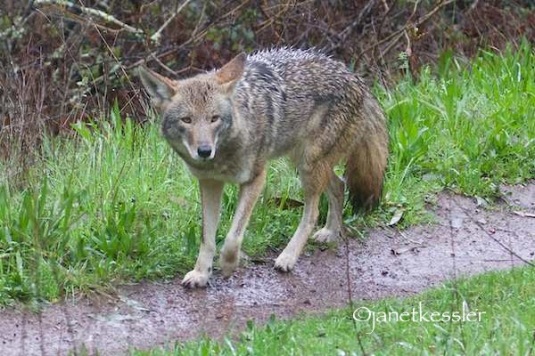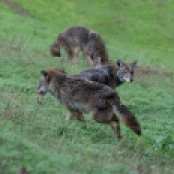
Seeing coyotes more often. Some folks believe, incorrectly, that coyotes become dangerous to humans and pets if they get used to seeing us: getting used to seeing us is called “habituation.” I’ve observed, first-hand, over the last eight years, the behavior of several generations of urban coyotes and their pups and never have seen habituation cause aggressive or dangerous behavior. A habituated coyote, per se, is not dangerous or aggressive; habituation is not the same as food-conditioning. All that may result from habituation is that they may allow themselves to be seen a little more, so you might see them more and you might see them at a closer distance. Coyotes are instinctively programmed to become used to and therefore ignore — habituated to — the same constant elements in their environment, and this includes a constant stream of humans. Not running quickly from people who have never bothered them is a coyote’s way of avoiding wasting unnecessary energy in human dominated areas. However, they retain their wariness of humans and will keep a safe distance and not approach us, and their other behaviors continue as before.
A habituated coyote is not a dangerous or aggressive coyote. One of the cure-alls which is being offered by some organizations to keep coyotes out of sight and away is “hazing”. Indeed, scaring a coyote from your and your dog’s immediate personal space is necessary and effective if you do it correctly. However, you cannot just generally “haze” a coyote and expect it to disappear from view forever because, over time, coyotes become used to the “hazing” — habituated to it — as they do other things in their environment. Rather than fleeing, the coyote may just stop and curiously look at the hazer, or take longer to flee. And this is when folks begin to interpret that failure to flee as “habituated and therefore bold and dangerous”: again, this is an incorrect assumption. The hazers have simply taught the coyote, over time, that hazing is something else in their environment which they must get used to. Again, these coyotes retain their wariness of humans and will not approach us.
Seeing an incident of “communication” for what it is. What I have seen is coyotes attempting to “communicate” or “message” their needs for space, personal safety, and territory to dogs. Please remember that coyotes keep other coyotes out of their territories by messaging them in the same way they message dogs. Only one coyote family occupies any particular territory. Dogs, especially very active ones, are seen no different than any other interloper coyote. Coyotes communicate with dogs and interloper coyotes in the only way they can: by “showing” their needs, often via an antagonistic display, a series of charges and retreats, or, sometimes, a nip to the haunches. Coyotes are superb communicators — many of us who have been walking our dogs and seen this behavior “get it” — we see it for what it is. When we respect their needs, their need to communicate in this manner stops. But some communities are taking this to the next level by saying these animals must be proactively eliminated, “because they are a danger to the community”. In fact, simple precautions of leashing and knowing how to shoo off a coyote from your personal space will solve the issue without resorting to the draconian kill solution, an approach which will simply disrupt a stable resident family of coyotes and create bigger issues for their human neighbors. Coyotes actually keep additional coyotes from entering their territories by using this communication behavior, thusly controlling the population size in the area.
So-called “Bold” behavior explained: “messaging”. What I have seen is that someone in every coyote family has a stronger “position” or “duty” to keep things safe. And this is not necessarily the alpha — it could be a beta. A coyote with this behavior is the one which some communities are targeting and calling “bold” and therefore “dangerous to humans”. Many folks now know that this coyote, if killed, will soon be replaced by another — the vacated position will soon be refilled — so killing the coyote serves no real purpose in reducing the population of an area. Those in favor of lethal removal now say that what they are really trying to eliminate is the “bold” coyote. But, it is also erroneous to suppose that in killing a coyote, the “bold” behavior is what will be removed, and that a milder coyote will replace the killed one. There is no evidence or justification for this thinking. The “role” and “duty” involving taking on protective behaviors to benefit the family and its territory, will also be taken over by another coyote. That position will always be there. This is why you don’t kill what you may perceive as a “bold” coyote. So, killing neither changes the number of coyotes in a territory, nor does it eliminate the existence of a more “bold” coyote. And an additional problem with eliminating resident coyotes is that a newcomer “replacement” will have to learn, over time, what the original coyote already knew about urban living and coexistence, and the way he may learn this is through trial and error involving more encounters with people and pets, and by visiting more yards.
The only effective approach for dealing with this situation is to thoroughly educate the public about coyote behavior, and to set appropriate guidelines — including a warning always to avoid totally by walking away from a coyote if you have a dog — this will discourage an interaction — by eliminating the circumstances and the opportunity for an interaction; BUT, be prepared to effectively shoo the coyote away if it approaches into your and your dog’s personal space; and put up signs advising folks that this isn’t the best place to walk dogs at the moment. This is enough to prevent further incidents. This is what we do in San Francisco and it is effective.
Small pets may be seen as prey. Regarding pets as prey, again, coyotes can’t distinguish between who is your pet and who isn’t — small animals look like prey. Coyotes are not targeting your pets to take them from you in order to be aggressive, they are simply fulfilling their need to survive. Therefore, small pets need to always be kept under supervision where there is wildlife. And a tit-for-tat retribution isn’t going to solve anything. Removing a coyote, even if you get the right one, which is extremely unlikely, will not bring back your pet, nor will it prevent future unguarded pets from being taken. What will solve the issue is guarding pets and keeping them out of harm’s way, the same as you do, hopefully, as you cross the street.
Coyotes may visit yards and even come up on your porch. They are exploring, curious and looking for food, often enticed by strange and strong smells. Get rid of all food attractants and scare them off to teach them that you don’t want them there. You may have to do this a couple of times, but they will learn.
No Need To Kill Coyotes. You don’t need to kill coyotes, ever, unless they have rabies — the possibility of which is exceedingly small — or unless there is something going on beyond what I’ve described above. The rare incident between a dog and a coyote, as described above, is bound to occur on occasion, but keep in mind that, in the scheme of things, the number of these incidents is minor.
Ecology, Environmentalism, Sustainability. Again, I want to repeat what I’ve said before: The driving ethos these days is “environmentally friendly” and sustainability”. Environmentally friendly means not destroying what nature has given us — it means developing guidelines which inflict minimal or no harm on the environment: coyotes are part of our natural environment. The idea of sustainability resulted from concerns about how humans and our “needs” were altering healthy and balanced ecosystems, which was coming back to haunt all of us. It turns out that we don’t need to destroy so much — we don’t need to kill these animals, and we actually should not do so. They are part of the system and they help keep it balanced.
Here is a clarification of the three terms, defined by me as I use them in this posting:
Shooing off/scaring a coyote. This is a method to scare a coyote away who is in your personal space or approaching your personal space or in your yard. It always involves stepping in the direction of the coyote, sometimes aggressively, to make it move. It is very straight forward: nothing more is accomplished than simply making the coyote move away. You may have to repeat this at some future point, but the coyote will soon learn that he should not approach you. A pamphlet which describes this can be found here: “How to Handle A Coyote Encounter”. And, IF the coyote doesn’t move, it is suggested you call it a day and leave the coyote alone — there are reasons for a coyote’s behavior that have nothing to do with the concept of “habituation”, such as pup protection.
Hazing. This also is a method of scaring coyotes away, not dissimilar from shooing a coyote away. But this is a term, as I see it, has added concomitant meanings. The premise behind this term is that “*habituated* coyotes are a danger, so the goal is to re-instill fear of humans into every coyote.” The expectation is that the coyote will then stay away and out of view. When coyotes don’t respond to this treatment as expected because they’ve become “habituated” to the scare tactic itself, this coyote now is considered, incorrectly, even more of a danger and becomes the target for lethal removal — it results in increased human fears of coyotes. Please note that coyotes do not lose their innate wariness of humans due to habituation, no matter how often they see us.
Behavior modification, or conditioning is a method of shaping learning which depends on rewards and punishments. It is used to modify very specific behaviors, not just that a coyote has been seen in a field. Food conditioning falls into this realm. Coyotes are rewarded for coming into your property when there is food there. If food continues to be there, they will continue to come. To break this conditioned response, first, remove all coyote attractants. If this is not enough to deter a coyote, the opposite of a reward is instituted: a punishment is offered which will deter the animal. It is focused on a behavior instead of merely the coyote’s presence. In this case, the coyote is looking for food in a particular place. You may harass, vex, haze or scare off (use what term you will) the coyote at this point, by banging together pots and pans, or turning a forceful flow of water on the coyote with a hose. Although the coyote may still come around for a while to check for food, without the food, and with the additional harassment, the coyote is not likely to *hang around*. If you need additional help, please call your local Animal Care and Control.



















